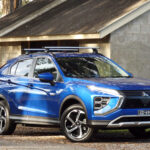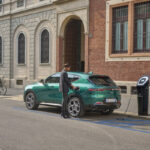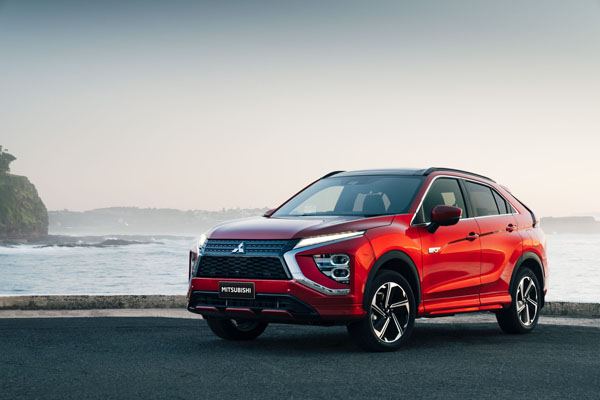
Eclipse Cross is the fourth member of the Mitsubishi SUV family which, together, account
for nearly 60 per cent of the Japanese company’s total Australian sales. Indeed, only one
traditional passenger car, the small Mirage hatchback, has survived the trend towards
SUVs and light commercial vehicles.
Launched here in December 2017 the Eclipse Cross fits into the space between the
compact ASX and the medium-large Outlander (all three sit on what is effectively the same
platform), with the full-size Pajero Sport at the top of the tree.
In April 2021 Eclipse Cross joined the Outlander in being available as a Plug-In Hybrid
(PHEV). It comes in three variants: ES, Aspire and Exceed.
Our test car was the top-of-the-range Exceed.
STYLING
To our eyes the Eclipse Cross is the most attractive vehicle in its class with a nice blend of
SUV functionality and a semi-sporty profile. The front has boomerang shaped chrome
element framing a black honeycomb grille below Mitsubishi’s signature Dynamic Shield
badge.
Twin vertical headlights give it a tall look and above them are LED daytime running lights
which flow around to the side. All models get 18-inch alloy wheels.
The battery charging plugs are at the right rear with the choice of a standard Type 2 AC
socket or a DC point which can also be used for V2H (Vehicle To Home) charging of
things like camping equipment.
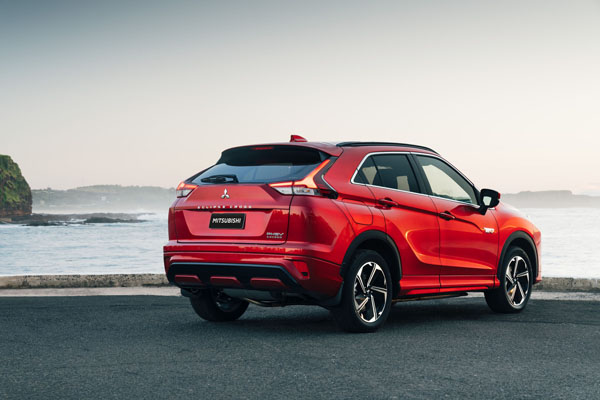
INTERIOR
Entry into the Eclipse Cross doesn’t cause any problems and once inside it has the feel of
a larger vehicle with plenty of head, leg and elbowroom in the front. The seats are wide
and comfortable enough for long-distance travel.
Rear seat space isn’t as good with relatively tight leg and headroom.
The dashboard has a neat and functional design with most features easily accessible. The
instrument panel has carbon and piano black accents as do the steering wheel, centre
console and door panels. The lower dash, centre console, arm rests and air vents all have
a high finish silver trim.
A revised instrument cluster displays engine speed as well as EV charge levels and
battery use – but no digital speedo.
The entry-level Eclipse Cross ES comes with cloth trim, two-zone climate air conditioning,
and push button start. Aspire adds suede and synthetic leather trim, heated front seats
and powered driver’s seat while Exceed gets full leather, heated rear seats, heated
steering wheel, power passenger seat, head-up display and a dual sunroof.
Boot space is a modest 359 litres in the PHEV, 46 litres less than the standard Eclipse
Cross models.
POWERTRAIN
The Eclipse Cross PHEV combines a 2.4-litre petrol four-cylinder engine with a 13.8kWh
battery powering front and rear electric drive motors.
The engine produces 94kW of power and 199Nm of torque, while the electric motors
deliver 60kW/137Nm and 70kW/195Nm.
Like other hybrids the petrol engine recharges the battery either directly or through brake
regeneration.
Drive is to all four wheels through a reduction, single-speed transmission.
SAFETY
Standard safety features across the Eclipse Cross PHEV range include seven airbags;
ABS brakes with Emergency Brake Assist and Electronic Brakeforce Distribution; Forward
Collision Mitigation system with Pedestrian detection; Lane Departure Warning;
Emergency Stop Signal; Hill Start Assist; Active Stability and Active Traction Control; Isofix
child seat anchor points; and reversing camera.
Aspire adds Adaptive Cruise Control; Blind Spot Warning; Lane Change Assist; Rear
Cross Traffic Alert; front and rear parking sensors; and a Multi Around Monitor.
Exceed caps off the safety list with Ultrasonic Miss-acceleration Mitigation which reduces
the chance and severity of hitting obstacles when the driver mistakenly presses the
accelerator when stationary or at speeds of up to 10km/h.
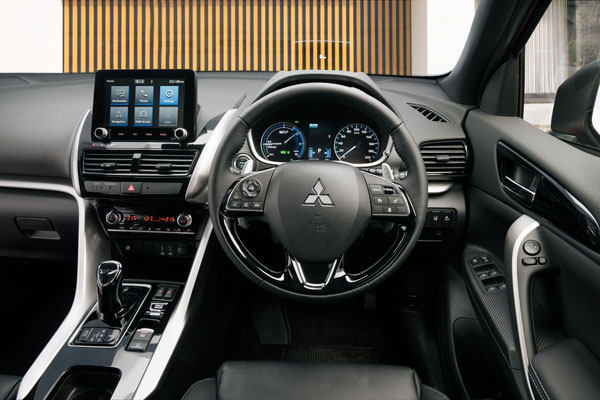
INFOTAINMENT
Display is through a very basic 8.0-inch touchscreen across the range that’s not especially
responsive. There’s Bluetooth with voice control, AM/FM and DAB+ digital radio, wired
Apple CarPlay and Android Auto and four-speaker audio.
Aspire adds a premium Mitsubishi Power Sound System that includes eight speakers, four
tweeters. Exceed is the only grade with built-in navigation.
DRIVING
Eclipse Cross PHEV has three different drive models. In EV Mode (activated though a
button next to the gear lever) the battery sends power to the front and rear electric drive
motors.
In Series Hybrid Mode the vehicle continues to use the battery and motors while the petrol
engine is engaged to run the generator to charge the battery while driving.
Parallel Hybrid Mode operates like a traditional hybrid. This means the petrol engine drives
the front wheels in tandem with the front electric motor while the rear electric motor drives
the rear wheels.
Unlike other PHEVs which lock-in the EV mode until the battery is almost flat, the Eclipse
Cross defaults back to Parallel Hybrid mode each time the vehicle is stopped and re-
started.
All modes use regenerative braking to charge the battery and can be adjusted via paddles
on the steering wheel.
Mitsubishi claims an EV-only range of 55 kilometres from the Eclipse Cross PHEV under
the old NEDC standard and 45km according to the newer (and more realistic) WLTP
system. The best we could manage, in normal driving, during our week-long test was
38km.
Mitsubishi, like other PHEV makers, shows a very misleading fuel consumption figure in its
spec sheet. In the case of the Eclipse Cross, it’s 1.9 litres per 100km. The claim is based
on starting with the battery fully charged, travelling 55 km in EV mode before switching to
hybrid mode for the remaining 45km, then stopping to re-charge the battery before
proceeding beyond the 100km distance. A highly unlikely scenario.
Out on the road Eclipse Cross PHEV is an easy car to navigate around the city and
shopping centres helped along by a fairly tight turning circle and light steering. We love the
EV experience with its silent ambiance combined with the instant acceleration which is a
feature of electrification.
Handling is pretty good for an SUV with less body roll than others in its class that we’ve
driven.
Steering is well-weighted but without much feedback.
SUMMING UP
The Mitsubishi Eclipse Cross has long been one of our favourite mid-sized SUVs. We love
its looks, practicality and driveability.
The big question is whether the price premium of $12,500-plus for the PHEV over the
equivalent specced 1.5-litre turbo-petrol versions can be justified for such a limited EV
range. Even with a home and charger and limited travel distances it’s going to take many
years to recover that extra cost.
All Mitsubishi vehicles come with a 10 year / 200,000 km warranty on most of the vehicle
provided that all servicing is done at its dealerships. Otherwise, the warranty reverts to five
years and 100,000 km. So, be wary if you’re consistently averaging more than 20,000 km
a year.
The warranty on the PHEV battery is eight years or 160,000 km.
AT A GLANCE
MODEL RANGE
Eclipse Cross PHEV ES AWD: $46,490
Eclipse Cross PHEV Aspire AWD: $50,490
Eclipse Cross PHEV Exceed: $54,490
Note: These prices do not include government or dealer delivery charges. Contact your
local Mitsubishi dealer for drive-away prices.
SPECIFICATIONS (Mitsubishi Eclipse Cross PHEV Exceed five-door wagon)
PETROL ENGINE:
Capacity: 2.4 litres
Configuration: Four cylinders inline, Atkinson cycle
Maximum Power: 94 kW @ 4500 rpm
Maximum Torque: 199 Nm @ 4500 rpm
ELECTRIC MOTORS:
Front electric motor: 60 kW/137 Nm
Rear electric motor: 70 kW/195 Nm
Fuel Type: Standard unleaded petrol
Combined Fuel Cycle (ADR 81/02): 1.9L/100km
CO2 Emissions: 43g/km
Battery capacity: 13.8kWh
DRIVELINE: Single Speed Transmission reduction gear, all-wheel drive
DIMENSIONS, WEIGHT AND CAPACITIES:
Length: 4545 mm
Wheelbase: 2670 mm
Width: 1805 mm
Height: 1685 mm
Turning Circle: 10.8 metres
Kerb Mass: 1895 kg
Fuel Tank Capacity: 45 litres
BRAKES:
Front: Ventilated disc
Rear: Solid disc
STANDARD WARRANTY:
10 years/200,000km (when serviced with Mitsubishi)
Battery 8 years/160,000km
RATINGS:
Looks: 9/10
Performance: 8/10
Safety: 8/10
Thirst: 7/10
Practicality: 8/10
Comfort: 8/10
Tech: 8/10
Value: 6/10




